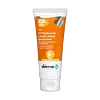What's inside
What's inside
 Key Ingredients
Key Ingredients

 Benefits
Benefits

 Concerns
Concerns

 Ingredients Side-by-side
Ingredients Side-by-side

Water
Skin ConditioningCyclopentasiloxane
EmollientEthylhexyl Methoxycinnamate
UV AbsorberTitanium Dioxide
Cosmetic ColorantDiethylhexyl Butamido Triazone
UV AbsorberCetyl PEG/PPG-10/1 Dimethicone
EmulsifyingAluminum Chlorohydrate
AstringentDimethicone/Vinyl Dimethicone Crosspolymer
Skin ConditioningZinc Oxide
Cosmetic ColorantCoco-Caprylate/Caprate
EmollientPolyglyceryl-3 Polyricinoleate
EmulsifyingIsostearic Acid
CleansingIsododecane
EmollientDisteardimonium Hectorite
StabilisingPropylene Carbonate
SolventBis-Ethylhexyloxyphenol Methoxyphenyl Triazine
Skin ConditioningHyaluronic Acid
HumectantPhysalis Angulata Extract
Skin ProtectingCaprylic/Capric Triglyceride
MaskingTocopherol
AntioxidantFructooligosaccharides
HumectantBeta Vulgaris Root Extract
Skin ConditioningGlycerin
HumectantButylene Glycol
HumectantSodium Benzoate
MaskingPhenoxyethanol
PreservativeWater, Cyclopentasiloxane, Ethylhexyl Methoxycinnamate, Titanium Dioxide, Diethylhexyl Butamido Triazone, Cetyl PEG/PPG-10/1 Dimethicone, Aluminum Chlorohydrate, Dimethicone/Vinyl Dimethicone Crosspolymer, Zinc Oxide, Coco-Caprylate/Caprate, Polyglyceryl-3 Polyricinoleate, Isostearic Acid, Isododecane, Disteardimonium Hectorite, Propylene Carbonate, Bis-Ethylhexyloxyphenol Methoxyphenyl Triazine, Hyaluronic Acid, Physalis Angulata Extract, Caprylic/Capric Triglyceride, Tocopherol, Fructooligosaccharides, Beta Vulgaris Root Extract, Glycerin, Butylene Glycol, Sodium Benzoate, Phenoxyethanol
Water
Skin ConditioningEthylhexyl Stearate
EmollientIsopropyl Palmitate
EmollientButyl Methoxydibenzoylmethane
UV AbsorberGlycerin
HumectantDicaprylyl Ether
EmollientEthylhexyl Salicylate
UV AbsorberOctocrylene
UV AbsorberEthylhexyl Triazone
UV AbsorberCetearyl Alcohol
EmollientGlyceryl Stearate
EmollientSodium Stearoyl Glutamate
CleansingDiethylhexyl Butamido Triazone
UV AbsorberMicrocrystalline Cellulose
AbsorbentPhenylbenzimidazole Sulfonic Acid
UV AbsorberSodium Hydroxide
BufferingTocopheryl Acetate
AntioxidantCellulose Gum
Emulsion StabilisingTitanium Dioxide
Cosmetic ColorantCaprylyl Glycol
EmollientDecylene Glycol
Skin ConditioningPiroctone Olamine
PreservativeXanthan Gum
EmulsifyingDiethylhexyl Sodium Sulfosuccinate
CleansingSilver Chloride
PreservativePropylene Glycol
HumectantWater, Ethylhexyl Stearate, Isopropyl Palmitate, Butyl Methoxydibenzoylmethane, Glycerin, Dicaprylyl Ether, Ethylhexyl Salicylate, Octocrylene, Ethylhexyl Triazone, Cetearyl Alcohol, Glyceryl Stearate, Sodium Stearoyl Glutamate, Diethylhexyl Butamido Triazone, Microcrystalline Cellulose, Phenylbenzimidazole Sulfonic Acid, Sodium Hydroxide, Tocopheryl Acetate, Cellulose Gum, Titanium Dioxide, Caprylyl Glycol, Decylene Glycol, Piroctone Olamine, Xanthan Gum, Diethylhexyl Sodium Sulfosuccinate, Silver Chloride, Propylene Glycol
Ingredients Explained
These ingredients are found in both products.
Ingredients higher up in an ingredient list are typically present in a larger amount.
Diethylhexyl Butamido Triazone is a photostable UV absorber. It protects in both the UVB and UVA II range.
The great thing about this ingredient is that it is ultra-photostable at low concentrations.
It is also pretty water-resistant and is highly oil-soluble (so your oil cleanser will get it off right away).
This ingredient is currently available in Europe and Japan, but not in the US.
Learn more about Diethylhexyl Butamido TriazoneGlycerin is already naturally found in your skin. It helps moisturize and protect your skin.
A study from 2016 found glycerin to be more effective as a humectant than AHAs and hyaluronic acid.
As a humectant, it helps the skin stay hydrated by pulling moisture to your skin. The low molecular weight of glycerin allows it to pull moisture into the deeper layers of your skin.
Hydrated skin improves your skin barrier; Your skin barrier helps protect against irritants and bacteria.
Glycerin has also been found to have antimicrobial and antiviral properties. Due to these properties, glycerin is often used in wound and burn treatments.
In cosmetics, glycerin is usually derived from plants such as soybean or palm. However, it can also be sourced from animals, such as tallow or animal fat.
This ingredient is organic, colorless, odorless, and non-toxic.
Glycerin is the name for this ingredient in American English. British English uses Glycerol/Glycerine.
Learn more about GlycerinTitanium dioxide is a mineral UV filter widely used in sunscreens and cosmetics.
It is one of only two UV filters officially classified as “mineral” by regulatory agencies, the other being zinc oxide.
Titanium dioxide provides broad-spectrum protection mostly in the UVB and UVAII range, with some protection in the UVAI range.
While its UVA protection isn’t as strong as zinc oxide’s, the difference is minor.
A common myth is that mineral UV filters reflect UV light. However, modern research shows titanium dioxide absorbs UV radiation like chemical filters (~95% absorption & 5% reflection).
Thanks to its non-irritating nature, titanium dioxide is suitable for sensitive, acne-prone, or redness-prone skin. It is unlikely to cause "eye sting" like other sunscreen ingredients.
A major drawback of this ingredient is its white cast and thick texture. This is why mineral sunscreens often leave a white cast and are less cosmetically elegant than chemical/hybrid sunscreens.
To improve white cast and spreadability, micronized or nano-sized titanium dioxide is often used.
There are ongoing concerns surrounding nano-titanium oxide's impact on marine ecosystems.
There is no conclusive evidence that any form of titanium oxide (or any other sunscreen ingredients) will cause harm to marine ecosystems or coral reefs. The science is still developing but many consumers are keeping a close eye on this issue.
Please note, many destinations have reef-safety sunscreen rules. For instance, the U.S. Virgin Islands advises all visitors to use non-nano mineral sunscreens.
Nano mineral sunscreens once raised safety concerns about absorption into skin.
Extensive research has shown that they do not penetrate healthy or damaged skin; they remain safely on the surface and the top layer of dead skin (stratum corneum).
You'll likely find titanium dioxide bundled with alumina, silica, or dimethicone. These ingredients help make titanium dioxide highly photostable; this prevents it from interacting with other formula components under UV light.
Learn more about Titanium DioxideWater. It's the most common cosmetic ingredient of all. You'll usually see it at the top of ingredient lists, meaning that it makes up the largest part of the product.
So why is it so popular? Water most often acts as a solvent - this means that it helps dissolve other ingredients into the formulation.
You'll also recognize water as that liquid we all need to stay alive. If you see this, drink a glass of water. Stay hydrated!
Learn more about Water